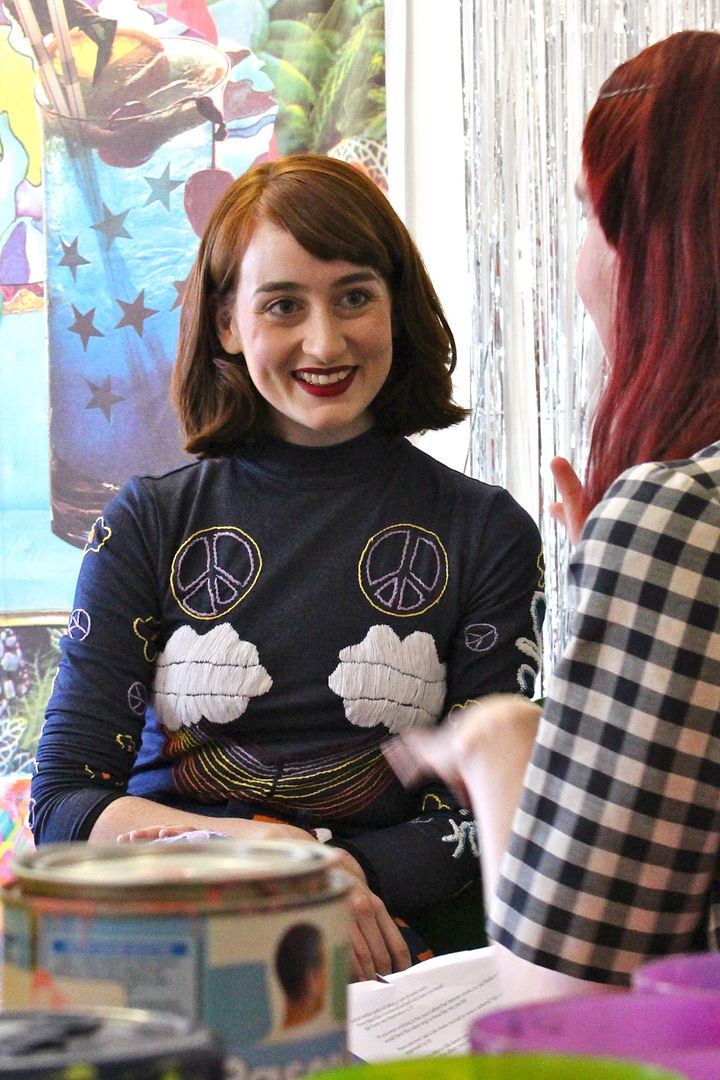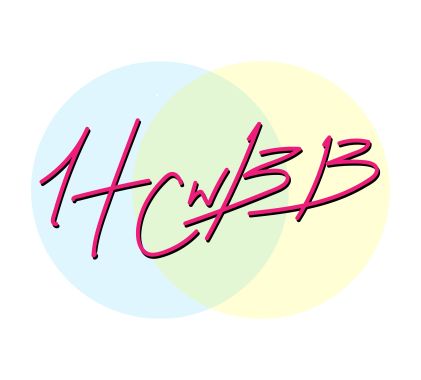Our Bloc Feature this week comes from the marvelous Hot Chicks with Big Brains.
Hot Chicks with Big Brains is an interview series determined to challenge the way women are often pigeonholed. Here you’ll find discussions with successful women who appreciate a curated sense of self. Women who are both form and function. Interviews begin by focusing on the relationship between work and personal style, but quickly (and often) digress into insightful life stories. There is also a blog section where HCwBB tracks the progress of past interviewees, discusses the latest publications of interest, and keep you updated on things they find inspirational, intriguing, and entertaining.
They have just launched a podcast for feminist + queer film discussion called Screen Queens and it goes hand-in-hand with a bi-monthly movie night we’ve started with Palace Cinemas!
You can pick up Issue #1 here!
Interview with Minna Gilligan
by
Lorelei Vashti
Photography by Bri Lee
I was so excited to have the opportunity to talk to the artist Minna Gilligan again. She released her stunning book, Time after Time, at the Melbourne Writers Festival last year, and I interviewed her as a part of the launch about her approach to clothing and style. This time I wanted to chat more about how her work impacts her style and ask whether she sees social media as being a big part of her job. I also wanted to get a peek inside her Gertrude Street studio! On a sunny Saturday morning in January, she met us downstairs and led us up through a tangle of corridors into her unmistakably Minna-esque sanctuary.

Lorelei Vashti: One of the reasons I wanted to interview you for HCwBB was because you’re someone for whom your art is your work is your life. So with that in mind, I wanted to start by asking how your job influences how you dress. Are there practical considerations you have to think of?
Minna Gilligan: I like to have a purpose when I wake up, with what I want to wear and how I want to feel when I wear it. I might think about it the night before, or I might just get up and have a vibe, or an idea, or a character that I might vaguely be imagining, and then I’ll get dressed.
I won’t often think practically, so I’ll find myself bending down, stretching canvas in heels. Or I’ll wear a silk dress, and many a time I’ve leant over and my baby doll dress has dropped in paint. I’ve ruined a lot of things like that. But I don’t mind. Clothes are made to be worn and to be used. And my favourite thing to do is to make work, so I want to be wearing the clothes I love the most and making work in them.
LV: So you will wear something that you’ve half ruined again? Like, something with paint stains on it or whatever?
MG: I will always keep it, and I do attempt to clean it! But if you can’t do anything then you’re like, ‘It’s a part of it now.’ Not that I’m going around with stained clothes all the time, but there are little things that.

LV: Your clothes are full of memories.
MG: Yes. Also, always drip little droplets of paint on shoes. I bought these new shoes from Alpha60, and I dropped fluro pink, like one little dot, on black, and I’m like, ‘Urgh; oh well. It’s there now so that’s that.’ I’ve done that a lot of times!
LV: I feel like people would pay a lot of money to have some Minna Gilligan custom paint-dripped shoes!
Laughter.
Now, to go back a bit, I know that we both have the same feeling about clothes, and about how they can hold stories and meaning. I really think that fashion is less about “me me me”, and instead connects us to a bigger story. Your book is all about stories about connection. When were you first aware that clothing had “magical powers”?
MG: Yeah, I can sort of pinpoint a couple of moments. When I was really little it was a dress up box and this green organza eighties dress that was in there. I remember as a child putting that on and feeling different, or elevated, or special, and taking a nap in it, and wanting to just wear it. And then when I was a teenager, it was when I first went into a Savers store on a whim, maybe looking for something outside of surf brands or Supre or whatever. I remember finding things and then cutting and shortening things—you know, really badly—but realising that I had this control and I could curate these outfits and they could evoke certain feelings or inspirations.
LV: There’s this idea of being a character and feeling different when you wear something.
MG: Yeah, and being a part of a larger narrative. Having control over that, and being a protagonist. It’s not vanity, but it is about wanting to curate a scene or an escape.
LV: Well that brings me to something I don’t think I’ve ever asked you before.
MG: Oh!
LV: Well, I’m going to call you an Instagram star. I hope that’s okay.
MG: Oh, that’s okay!
LV: Would you consider your daily social media posts, like Instagram and your blog, as a part of your work?
MG: Yeah, definitely. I really like having a presence that’s accessible to a lot of people and that can then lead into getting more people to view my art. So I think ultimately, I’m really into art being accessible. I’m not into insider language, or just artists talking to each other via their work. You know, that’s fine, but that’s not really what I want to achieve. I want a wider audience and appreciation, and to reach as many people as I can. So obviously Instagram is a way in which I can do that. And whether it’s by posting a selfie, which can be great—it can get people to sort of … it comes back to what you said before about how I do live my art and stuff like that. So a selfie is perhaps as equal as posting a drawing, and it’s just another expression and another means of getting me and my work out there. So yes, definitely, it’s part of my practice, and it’s obviously really highly curated and I think about it a lot.
LV: So does that change how you dress every day? Knowing that you might post a selfie that day, does that come into it?
MG: Not really. I think it would be the other way round. I don’t dress to take a photo, but I might take a photo because I’m dressed a certain way.
LV: I wanted to ask you about your biggest professional disappointment and how it has affected your sense of self. I don’t know if that’s an abstract kind of question.
MG: <Thinks for a moment>
Yeah. I had some criticism that I was given that was really devastating for me. Someone who I’d been really close to for a long time took it upon themselves to tell me that they thought I had been going down a “bad road” with my artwork, that it was getting too commercial, and that was concerning this person. And this person said that other people had been talking—like curators and industry people—about how I was making bad decisions, and that it wasn’t doing me any favors and that kind of thing. That by doing illustrations on the side, or a blog post, or doing an Instagram post where somebody had sent me something … you know, those kinds of things. I don’t do it a lot, but it has happened.
And I was completely disappointed by that because I always thought I really was careful with walking that line between commercial and fine art, and also I don’t believe that it has to be clear anymore. I want to make a living and I want to do both of these things, so should I have to sacrifice one for the other, and does one lessen the impact of the other?
So, I’m over it now. I thought a lot about it and talked to a lot of people. I talked to my gallerist a lot, and to my parents who I really respect and they have really great opinions, and I think unfortunately it’s just a way in which people don’t enjoy that they can’t pigeonhole me in a specific thing. So, ‘Oh, I’m a painter, but I also blog, and I have an Instagram.’ And I think it makes them uneasy.
And that’s fine, and it’s just not the way that most people think an artist should practice. Increasingly, I think things are becoming so multi-disciplinary and blurry and everyone’s an artist, and everyone’s not an artist. I always prided myself in having navigated that, I thought, really well. I was completely devastated; I think ‘cause my own sense of what was right and wrong had been questioned. I’m totally over it now, but I think that was one of the biggest things that really affected me, that really made me self-conscious about my work and about my decisions, because I’d never felt that before.

LV: Did it change how you went about your work?
MG: Yeah, I mean, I’ve always been really careful with what I say yes to in a commercial sense, and I’ve said no to a number of big opportunities that could have been great but I sort of sensed that maybe something wasn’t quite right for me. And, you know, it’s meant saying no to money. So it’s not like someone offers me money and I’m like, ‘Yeah!’ I say no a lot. I mean, it didn’t change the way that I do what I do because I still did have faith that I had done a good job; but it was shaken.
But I’m just continuing to make sure I’m asking people who I trust and then I go from there. I think that I am a bit more self-conscious about more commercial things, but I know that’s just a hangover from that incident so I just push through.
LV: I’ve had some similar incidents where something has been said, either publicly or privately, and I find myself going quiet a bit in public, not wanting to stand out as much. If I’m going out to places where I know these peers who might be judging me will be … I’m trying to explain this in how it relates to clothing, because it’s made me, in the past, want to be less flamboyant, and less showy, and more serious to try to prove something.
MG: I know what you mean. I had this idea; not an idea, it’s just a thing I think about. A lot of artists prefer to live in the shadows and have their work in the forefront, which is great, but I think the fact that I do put myself out there, as a person, as a woman, and as a woman who enjoys my physical appearance and embellishing that, people don’t always respond positively to that.
So yeah I think it would be easier if I was standing back and my work was out.
LV: People always say to let the work show for itself, but when you are the work of art as well …
MG: Yeah. And it wouldn’t be natural for me to do that; I don’t know why actually, but it just wouldn’t. It wouldn’t feel honest.
LV: I think it’s probably a common feeling for artists or other creative people whose work is very much tied into their identity and sense of self. But wow that’s a really interesting insight. I’m sorry that happened to you!
MG: That’s okay!
LV: Can we talk a little bit about your other work—your “work-work”? Because it must be kind of strange to jump between the two. I mean, all artists do have to have another job, most of them anyway.
MG: Yeah, a lot of them do, and because I don’t really make it that public, a lot of people don’t think that I do it, and then when I tell people that I work in a part-time job three days a week they’re like, ‘Woah, how do you do all that stuff then?’ They just think I’m full-time in the studio, which I wish I was! But I’ve got a job at Art Guide Australia. I do their web work there, their social media, and uploading articles. I’ve been there for three or four years now, so a long time. It’s a really good job! And you know, it’s in the industry so I’m always learning, and I get to go to galleries. But I do often feel pressed for time, pretty much a lot of my life.
LV: Let’s go back to dressing for that job then. Is it similar to what you’d wear into the studio?
MG: Yeah, definitely. I mean, it’s a small office, and you can sort of wear whatever you want. But I would tone things down a little, just slightly. Just because I know it’s not really where I want to feel that amazing in the way that I dress or look.
LV: Or attention?
MG: Yeah, I think it might be an attention thing as well. Although, if I’m going somewhere that evening I’d probably wear a regular outfit. I dunno, it’s sort of … I would tone it down a little if it was just a regular day at work, just because I’m not thinking about it. Although you’d probably see an outfit I would wear and you’d think, ‘Is that toned down?’ Or the people I work with are probably like, ‘She tones it down?’
Laughter.
Pick up the first edition of Hot Chick with Big Brains here!
Lorelei Vashti
Lorelei is a writer and book editor from Melbourne, Australia, currently gallivanting through Turkey, Spain and France. She tweets @loreleivashti.


